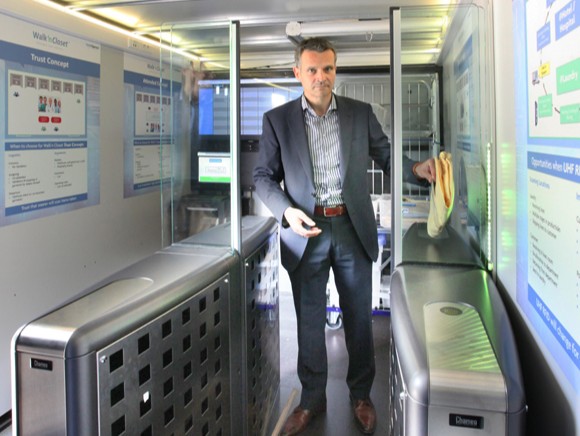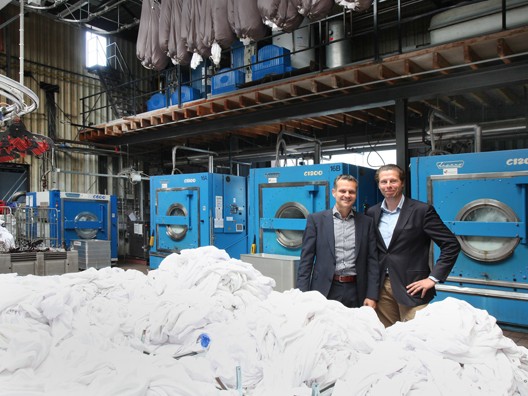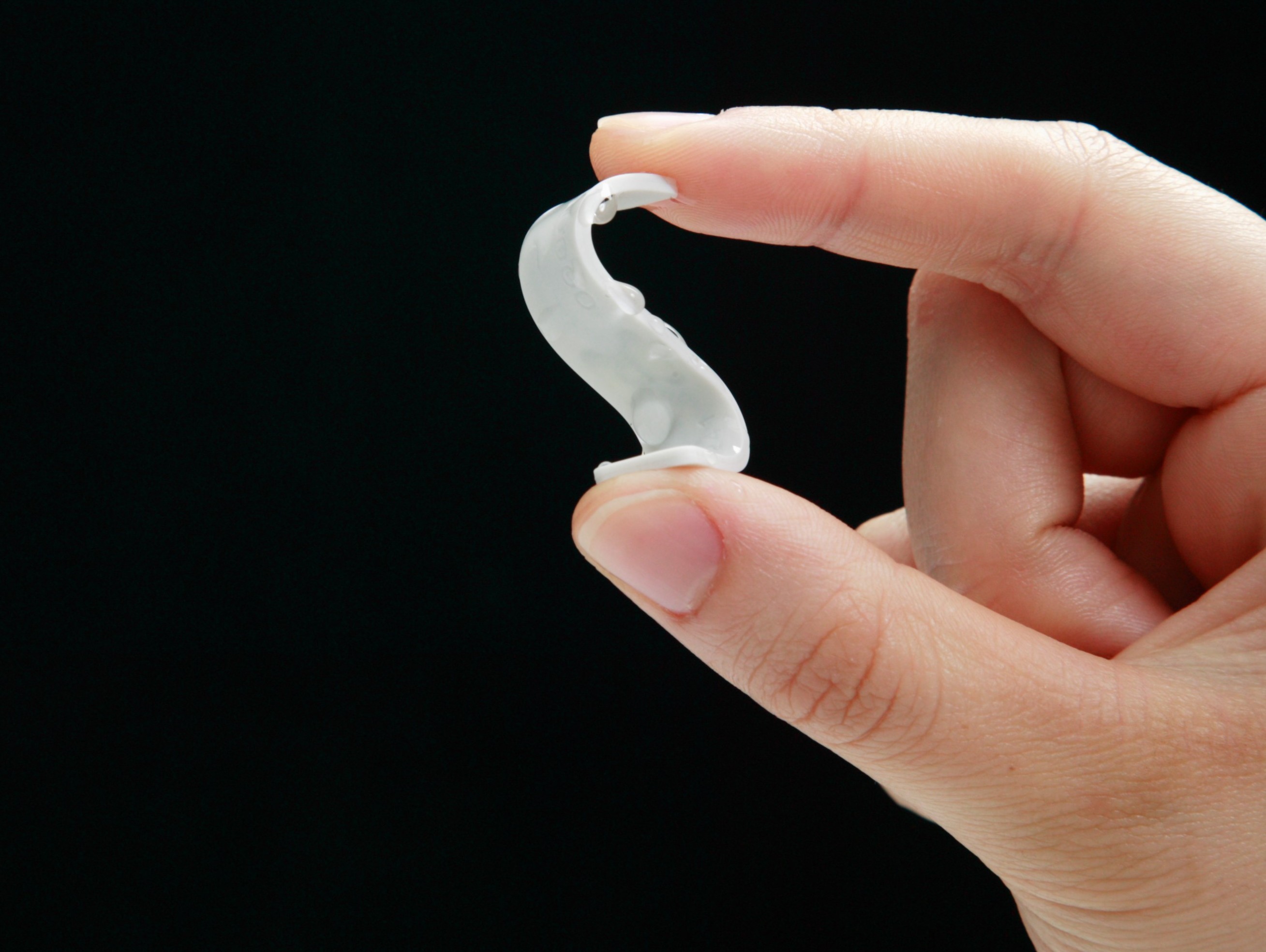
Every day, food manufacturing companies use large quantities of workwear in all shapes and sizes. However, they often lack insight into the logistics flows of their workwear and how to manage it. Vendrig, a company specialised in workwear rental and laundry, has launched the Walk ‘n Closet for workwear with track & trace based on UHF/RFID chips and UHF scanning.
There continues to be strong growth in tracking & tracing of products and goods flows using radio frequency identification (RFID). The technology utilises small electronic chips which are invisibly incorporated into products such as packaging materials making them easy to trace. RFID combined with ultra high frequency (UHF) scanning goes a step further: it makes it possible to trace the wearer, the on-site products and the products in bulk – ideal for workwear, for example. This forms the basis for the new Walk ‘n Closet concept for workwear, developed by Textilligence. Vendrig, a Dutch specialist in workwear rental and laundry based in IJsselstein, has introduced the system for food processing companies.
“Thanks to the UHF/RFID combination, Walk ‘n Closet immediately offers two benefits for the food industry: companies can register the clothing themselves, plus they can scan and read off the workwear in bulk (clothing per container),” explains Paul de Jonge, Walk ‘n Closet project manager and head of relationship management at Vendrig. Workwear supply is a process with lots of logistics movements. It starts with the weekly delivery from the laundry service, followed by the use within the company. “Then comes the question of where a particular item of clothing is located. Many food companies operate a workwear pool for their employees. Workwear is issued anonymously, based on size. The internal coordinator has no idea who is wearing which item and when. There is no clear overview of the repair costs per employee and no control over whether staff are wearing the correct size. Furthermore, employees tend to pick the newest and nicest-looking items first. Because their behaviour is anonymous, it is difficult to manage. Managing workwear use per department, for example to make a distinction between low-care and high-care production departments, can often be challenging too,” continues De Jonge, highlighting a number of practical situations. “An alternative solution, such as issuing personal workwear by name and storing it in individual employee lockers, requires a much larger quantity of workwear. Plus, extra clothing is required for all employees, including flexible workers. Walk ‘n Closet is targeted at the individual use of workwear and makes each employee responsible for their own work clothing.”
A flexible, durable UHF/RFID chip with a unique identification code has been incorporated into each item of clothing in the Walk ‘n Closet system. Employees are scanned upon entering and leaving the changing area. When employees enter the changing area, on-screen instructions tell them which container to collect their clean workwear from. At the end of their shift, before they leave the changing area, the system scans the chip to check that the dirty clothing has been placed in the laundry closet. Antennas at the entrance and in the laundry closet register each employee’s arrival, departure, collection and handing in of the workwear and automatically store the information about the wearer and the clothing in a database. Therefore, it is no longer necessary for an employee to supervise the use of workwear.
“With Walk ‘n Closet, we have made it possible to monitor the use of workwear individually, at wearer and wearer-moment level. The system provides continual insight into who is wearing which item of clothing and when it is handed in again. Walk ‘n Closet also helps companies to demonstrate their adherence to hygiene rules – e.g. that employees in high-care zones are wearing the required clothing and that it really is hygienically clean every day,” states De Jonge. The basic system for a food processing company comprises UHF/RFID-chip registration antennas in the changing areas. “But the system can also be supplemented with a turnstile at the entrance,” says Steven Smol, sales & marketing director at Textilligence, the company which developed Walk ‘n Closet. “In that set-up, employees are scanned before they pass through the turnstile and instructions are displayed on a screen. The system knows which workwear each employee needs. No further individual checks on issuing workwear are necessary.” Likewise, the system enables the flow of clothing between the company and the laundry service to be double-checked, in addition to the barcode scanning currently performed at Vendrig. The Vendrig employee has a pass which provides access to the customer’s changing area. After ascertaining that there are no problems with the container of dirty clothing, the Vendrig employee takes it away and replaces it with a container of clean workwear. Because the clothing items are also scanned at Vendrig, it is a closed-loop supply chain control process.
‘A solution to improve hygiene compliance and safety as well as workwear usage and workwear management costs’
Thanks to the savings made on personal supervision of the workwear flow, Walk ‘n Closet offers a rapid return on investment. The level of investment required depends on each company’s infrastructure, how many facilities must be equipped with Walk ‘n Closet registration and whether or not turnstiles must be installed. Savings can also be made within the changing area. Individual lockers for workwear can be replaced by roll containers so that the lockers no longer have to be kept stocked with clothing.

The system is a solution to help food companies improve their hygiene compliance and safety and reduce their workwear usage and workwear management costs. Because Walk ‘n Closet personally identifies each wearer of work clothing, the company gains insight into the costs based on precise management information. “While the sourcing costs of workwear generally tend to be stable, the management costs can vary considerably. A company’s internal distribution system can increase such costs dramatically. Walk ‘n Closet provides real-time information about workwear use and hence maximum control. Companies can save around 20% on their clothing pools through tailor-made workwear use and fewer washing cycles based on how dirty the clothes are,” says De Jonge in illustration. “For more expensive workwear, for instance, Walk ‘n Closet is a failsafe solution against items going missing or not being handed in.”

'A UHF/RFID chip with a unique identification code is incorporated into each item of work clothing'
However, the greatest saving lies in less handling and greater insight into the workwear management costs. Because Walk ‘n Closet indicates who is wearing which item of clothing and when, potential savings soon become apparent. “Manufacturing companies can accurately anticipate changes in processes and peaks in production, especially due to seasonal influences and the use of temporary staff, and adjust their workwear use per location accordingly. Work clothing can be precisely aligned with processes in low-care and high-care zones and employees can be tackled about their wearing behaviour thanks to the extra insight into repair costs,” concludes Paul de Jonge.
Source: Vendrig